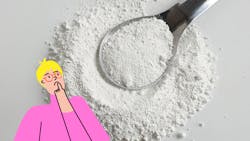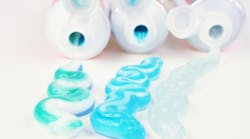Titanium dioxide in toothpaste: Should dental patients be warned?
Titanium dioxide is one of the last ingredients listed on a box of a toothpaste, but does that make it inconsequential? In recent months, this little-known but frequently used inorganic compound has been creating quite a stir internationally.
In May 2021 the European Food Safety Authority (EFSA) determined that titanium dioxide was no longer safe for human consumption due to carcinogenic risk factors and was officially banned after August 7, 2022.1 Meanwhile in the US, the Food and Drug Administration (FDA) allows titanium dioxide to be in toothpaste and also in many common food and cosmetic products.
Why don’t the two agencies’ views align? The US tends to take a more "reactive" stance with a “federalized approach to food safety,” while the European Union (EU) is far stricter, requiring evidence that proves safety before full approval is granted.2
What is titanium dioxide?
Titanium is a metal found in sand, ore, and soil that naturally interacts with oxygen to form a fine white powder, titanium dioxide (also known as E171). This inorganic compound has been found in many products throughout American kitchens and bathrooms for more than a century.
The primary purpose of titanium dioxide is for pigmentation due to the compound’s “excellent light-scattering property in applications that require white opacity and brightness.”3 Approximately 98% of all titanium dioxide produced is used for white pigmentation, including in food items such as candy, pastries, coffee creamers, and sauces. Secondary uses include toothpaste, lipstick, and cosmetics. The most well-known application of nanoscale titanium dioxide is in sunscreen due to its efficient ultraviolet absorption.
The research supporting its use or discontinuation is murky; complicating discussion around it is the differing views and regulations by the EFSA and the FDA. Currently, the majority of name-brand toothpastes on the market in the US contain approximately 1% titanium dioxide, as allowed by the FDA.1 This includes both conventional and natural toothpastes. In the EU, the EFSA’s concern that the cumulative effects of that amount of titanium dioxide on the body can’t be determined4 and the inability to prove its safety has resulted in its ban there.
Potential (yet uncertain) risks of titanium dioxide in toothpaste
There have been concerns within the EFSA regarding titanium dioxide’s categorization as a human carcinogen5 and potential risk of causing cancer. It was this potential that had prompted the EFSA to advise the EU to instate a ban throughout the EU on titanium dioxide in food products and food supplements due to the breakdown and accumulation of nanoparticles in the lungs, liver and other organs, but in November 2022, the Court of Justice of the European Union annulled that classification, along with any labeling requirements for products that contain titanium dioxide.6
At this time, research is limited only to rodents and doesn’t include any human subjects. Preliminary studies submitted to the EFSA suggest that the potential side effects are dependent on the mode of accessibility or transportation of titanium dioxide. As well, inhalation leads to the highest risk of cancer in animal studies, especially in the presence of nanoscale titanium dioxide.7
Titanium dioxide that is absorbed orally appears to present to little no adverse reactions, with minimal reactions when in contact with the eyes and skin.6 In the US, there are no Acceptable Daily Intake (ADI) limits for titanium dioxide, but products for consumption or absorption are limited by the FDA to no more than 1% titanium dioxide.
Where do we go from here?
At this time, further studies are needed to explore the effects of long-term exposure to titanium dioxide, but according to the current standards in the US, preliminary studies suggest that that the risks of exposure to 1% or less of titanium dioxide in toothpaste are low. A major factor in the lower risk is due to the expectoration of toothpaste, which decreases the risk of ingestion.
However, if a patient has concern about this ingredient or risk of ingestion, talk to them about products that better meet their needs. Until there’s a universal approach about titanium dioxide in toothpaste, dental care professionals should continue to tailor product recommendations that suit patients’ comfort levels or needs.
References
1. Titanium dioxide in food. Nourish by WebMD. Accessed January 23, 2023. https://www.webmd.com/diet/titanium-dioxide-in-food
2. Food standard showdowns – USA vs. the EU. The New World Report. Accessed January 23, 2023. https://www.thenewworldreport.com/food-standards-showdown-usa-vs-the-eu
3. Titanium dioxide. Chemical safety facts. Accessed January 24, 2023. https://www.chemicalsafetyfacts.org/chemicals/titanium-dioxide
4. Titanium dioxide – is it safe? Truthpaste. Accessed Feburary 2, 2023. https://truthpaste.co.uk/blogs/behind-the-truth/titanium-dioxide
5. Titanium Dioxide: E171 no longer considered safe when used as a food additive. European Food Safety Authority. Accessed February 27, 2023. https://www.efsa.europa.eu/en/news/titanium-dioxide-e171-no-longer-considered-safe-when-used-food-additive
6. Demetrakakes P. Court reverses EU ban on titanium dioxide. Accessed January 22, 2023. https://www.foodprocessing.com/business-of-food-beverage/international/news/21438611/court-reverses-eu-ban-on-titanium-dioxide
7. Davidson K. Titanium dioxide in food – should you be concerned? Accessed January 23, 2023 https://www.healthline.com/nutrition/titanium-dioxide-in-food
About the Author
Melissa Van Witzenburg, MS, RDH
Melissa has been practicing dental hygiene for 23 years. She continues to pursue her passion by educating the aging population about oral health and systemic links. Melissa also works clinically in a periodontal office in the Chicagoland area. For more information, email her at [email protected].


